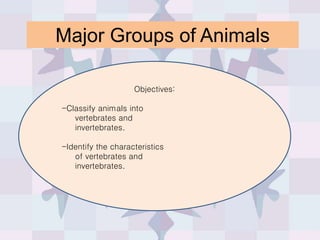
Major groups of animals
- 1. Major Groups of Animals Objectives: -Classify animals into vertebrates and invertebrates. -Identify the characteristics of vertebrates and invertebrates.
- 2. Major Groups of Animals A. Invertebrate-any animal lacking a backbone. Invertebrates are by far the most numerous animals on Earth.
- 3. Major Groups of Animals Invertebrates live in a vast range of habitats, from forests and deserts to caves and seabed mud. - Invertebrates are also found in the soil and in the air.
- 4. Major Groups of Animals Many invertebrates have no hard body parts at all. These soft-bodied invertebrates, keep their shape by maintaining an internal pressure.
- 5. Major Groups of Animals To defend against predators, other invertebrates have evolved exoskeletons, hard outer coverings such as the shells found in clams and mussels and the body cases that surround adult insects.
- 6. Major Groups of Animals Kinds of Invertebrates 1. Porifera – a marine animals that is full of pores or holes.
- 8. Major Groups of Animals 2. Coelentera or Cnidarians – also live in water, with soft bodies that enable them to float. - diverse group of aquatic, invertebrate animals armed with microscopic stinging structures.
- 9. Major Groups of Animals Cnidarians lack internal organs and they do not have digestive, circulatory, or respiratory systems. - cnidarians discharge waste matter through the mouth opening.
- 11. Major Groups of Animals 3. Platy Helminthes – these are animals that composed of flat worms with flat bodies.
- 12. Example of Platy Helminthes
- 13. Major Groups of Animals 4. Nematode – these are worm like animal with un segmented bodies.
- 14. Major Groups of Animals Many of them are economically and medically harmful, living as parasites in plants and animals, including humans.
- 15. Example of Nematodes Horsehair Worm
- 16. Major Groups of Animals 5. Annelida - these are animals with segmented bodies.
- 18. Major Groups of Animals 6. Mollusk are members of a phylum of soft- bodied animals with a hard external shell.
- 19. Major Groups of Animals The mollusk phylum is the second largest in the animal kingdom, after the arthropods.
- 21. Major Groups of Animals 7. Arthropod are animal with a hard, outer skeleton and a jointed body and limbs.
- 22. Major Groups of Animals Arthropods have adapte d to life on land, at sea, and in the air.
- 24. Major Groups of Animals 8. Echinoderma – these are aquatic animals that have spiny skins.
- 25. Major Groups of Animals The spines are particularly well developed in sea urchins. The skeleton, made up of calcium carbonate, may form a large proportion of the body, or, as in some sea cucumbers, it may be greatly reduced.
- 27. Major Groups of Animals B. Vertebrate are animal with a backbone, or spinal column, made of interlocking units called vertebrae.
- 28. Major Groups of Animals This strong but flexible structure supports the body and anchors the limbs, and it also protects the nerves of the spinal cord. - In all vertebrates, the spinal column forms part of a complete internal skeleton.
- 29. Major Groups of Animals Most vertebrates have jaws, and their brains are usually protected by a bony case called the cranium.
- 30. Major Groups of Animals Kinds of vertebrates 1. Fish is a diverse group of animals that live and breathe in water.
- 31. Major Groups of Animals Fishes are generally streamlined with a pointed snout and pointed posterior and a broad propulsive tail.
- 33. Major Groups of Animals 2. Amphibian are animal with moist, hairless skin through which water can pass in and out.
- 34. Major Groups of Animals Amphibians were the first animals with backbones to adapt to life on land. They are the ancestors of reptiles, which in turn gave rise to mammals and birds.
- 36. Major Groups of Animals 3. Reptile are animal with tough, dry skin covered with horny scales.
- 37. Major Groups of Animals Reptiles are vertebrates—animals that have a backbone. - they have lungs as the main organ of respiration.
- 39. Major Groups of Animals 4. Bird are animal with feathers and wings.
- 40. Major Groups of Animals Birds are members of a group of animals called vertebrates, which possess a spinal column or backbone.
- 41. Major Groups of Animals Birds have four-chambered hearts and are warm-blooded—having a relatively constant body temperature that enables them to live in a wide variety of environments.
- 44. Major Groups of Animals 5. Mammal are animal that raises its young on milk.
- 45. Major Groups of Animals Most mammals are covered with hair or fur, and most have specialized teeth that help them to cut or chew their food.
- 46. Major Groups of Animals Mammals include some of the most familiar members of the animal kingdom, such as cats, dogs, elephants, and whales, and also human beings—a species that now dominates life on earth.
- 49. References: The world of Science 5 Into the Future; Science and Health 5 BEC Handbook in Science 5 Encarta 2009